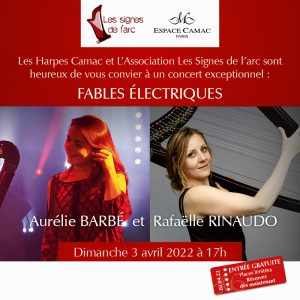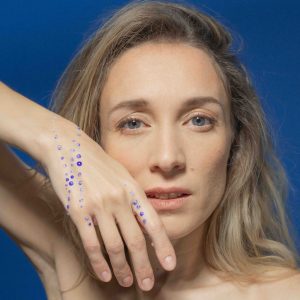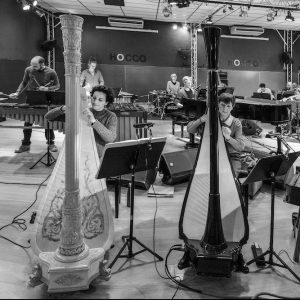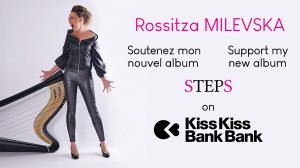Camac Blog
“Every note that resonates”: interview with Rossitza Milevska
News
March 20, 2024
Rossitza Milevska is one of the most versatile and accomplished harpists working in the field of jazz today. Classically trained, she was first musician every to graduate from the jazz course of the Nice conservatory majoring in harp. In 2022, she caught the attention of Ibrahim Maalouf, who invited her to join his Free Spirit Ensemble with whom she performs regularly. We caught up with her ahead of her concert at the Espace Camac this week, and talked about music, development and inspiration.
Having grown up in Bulgaria, Rossitza’s first steps in the musical world were, in common with many European children, through the rarefied atmosphere of the conservatory: “I was immersed in the world of the great classical composers thanks to my training at a specialised music school where only classical music was honoured.”
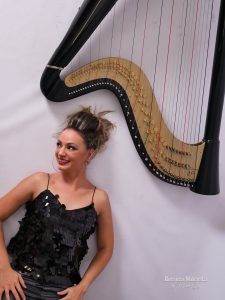
Portrait by ©Marion Gris
Whilst this was certainly beneficial in terms of culture, this meant the musical diet was not exactly a broad one: “In those days, other genres were unfortunately relegated to the background. However, the discovery of the Internet and access to international radio stations marked a turning point in my musical life. I marvelled at the works of artists such as Earth Wind and Fire, George Benson, Whitney Houston,Michael Jackson, Stevie Wonder, Babyface, George Michael, Chick Corea, Bill Evans, Miles Davis…etc.”
This opening of possibilities led Rossitza to a profound artistic discovery that would govern her art in the future: “ I understood that music had to move you, and that you could feel even freer when you wrote your own music and dared to improvise.”
By necessity, it also made Rossitza musically resourceful: “My teenage years were enriched by friendships with actors who were passionate about Broadway musicals, which enabled me to learn to play famous themes by ear on the piano.
We also took down the sheet music for the songs, a real challenge in Bulgaria at the time, where access to sheet music was limited.
These friends also introduced me to the legendary duets of Ella Fitzgerald and Louis Armstrong. The art of improvisation was revealed to me by deciphering their recordings, as was the world of George Gershwin. The world opened up to me, vibrant with color and possibility, inviting me to explore music in all its forms. “
Like so many young musicians, Rossitza began her musical journey at the piano. Jazz harpists like Corky Hale and Stella Castellucci have written about how the keyboard influences their approach to the harp – was it the same for Rossitza?
“My musical journey began with a deep affection for the piano, which I began exploring at the age of 6. It was my first contact with music, a beginning that later led to the discovery of the classical harp. Unlike the norm, I had the exceptional opportunity to complete my musical education by specialising in two main classical instruments. Before me, no one had obtained diplomas in two main disciplines, which made the situation quite unique.
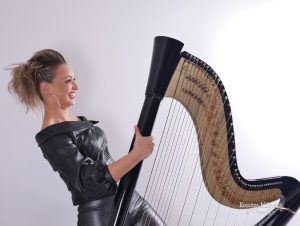
Rossitza Milevska: photo ©Marion Gris
Parallel to this formal training, and somewhat in secret, I developed melodies and arrangements for the piano, before attempting to adapt them to the harp. These attempts were often unsuccessful, mainly because there was no one around to guide my exploration of jazz and pop styles on the harp in Bulgaria. The piano, however, provided me with a solid foundation, improving my quick thinking and ability to adapt songs on the spot, which solidified my belief that anything was possible on the harp too.”
While it is with the harp that Rossitza has forged and enviable career, she maintains a deep sense of gratitude to her earlier classical studies at the piano:
“The piano, while the foundation of my foray into jazz on the harp, was complemented by my classical music training, which equipped me with the knowledge to excel. Thanks to the piano, I was also able to work with exceptional jazz teachers at the Nice Conservatory, which enabled me to gradually integrate the harp into jazz, defying expectations and proving that jazz on the harp is not only possible but deeply rewarding.”
It also means that Rossitza draws on an rich variety of sources, from across all genres:
“I find inspiration in the works of composers and artists from all eras. To name but a few, in no particular order: Bach, Chopin, Rachmaninov, Tchaikovsky, Debussy, Bernstein, Yo-Yo Ma, John Williams, Bobby McFerrin, Michael Jackson, Quincy Jones, Jacob Collier, Bill Evans, Take 6, Sylvain Luc, Richard Bona, Pat Metheny, Beyoncé and En Vogue. My list is endless!”
When it comes to the harp, Rossitza was galvanised by the trailblazing example of artists like Deborah Henson Conant: “The example of Déborah Henson-Conant, who sang while accompanying herself on the harp, was a great source of inspiration for me.” She is furthermore inspired by Dorothy Ashby, Lori Andrews, Jakez François and Park Stickney.”
The connectivity of the international harp community has also led to fruitful contact from a host of other artists: The connectivity of the international harp community has also led to fruitful contact from a host of other artists. In the course of her travels she has been able to share ideas with Edmar Castañeda, Motoshi Kosako, Amanda Whiting and Ben Creighton Griffiths.
“ The world is full of beautiful discoveries; you just have to stay open-minded and let yourself be carried away by every note that resonates.”
At her concert with us in Paris, Rossitza will be joined by Jérôme Achat. We asked her: What’s special about working with a drummer as a harpist?
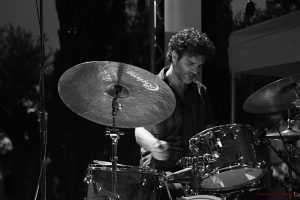
Jerôme Achat
“Playing with a drummer like Jérôme Achat is always a pleasure. […] A harp-drum duo is quite unusual, requiring attentive listening and constant adaptation to each other’s musical proposals. This involves grasping nuances, choosing the ideal moment to express oneself and leaving space for the other. It’s a musical conversation that creates a magical atmosphere, while preserving the beauty of the music and the pleasure of sharing.”
Of course, we are extremely proud that Rossitza chooses Camac for her work:
“The use of the Camac electroacoustic harp enriches every aspect of our duo. It allows me to explore different sounds and means of expression. I particularly appreciate the balance between the harp’s natural acoustic sound, in dialogue with the drums, and the possibilities it offers for full, rich musical expression.”
We encourage you all to come and hear this rich expression, magical atmospheres and the spontaneity of live collaboration at the Espace Camac on 22 March- entry is free upon reservation.

